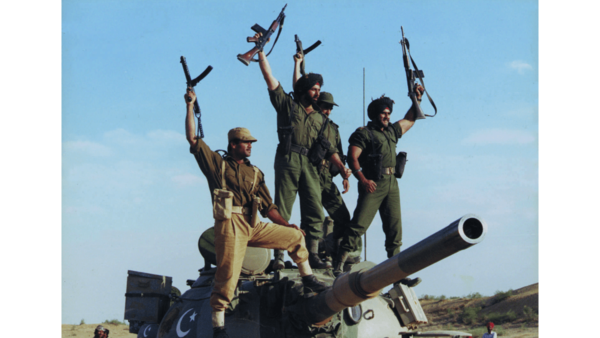Border, Swades, Lakshya: In Search Of A Good Independence Day Film
A 'good' Independence Day film is as subjective as the patriotism that summons its ideals, writes Manik Sharma.

Last Updated: 05.11 AM, Aug 13, 2023
MY clearest memories of Independence Day aren’t about the ones spent at neighbourhood functions or school events. They are about tucking ourselves — a family of three — into the warmth and comfort of a good film. An entire generation in India has grown up with this ritual, surrendering to the crowd-pleasing wonders of a ‘deshbhakti wali’ film on national television. Spies, freedom fighters, righteous men and women — all appeased the average Indian living room with stories of valour and validation.
As a result, cinema has shaped our ideas of patriotism, be it the hardened external edges or the soft inner curves. Between the two we externalised our anxieties, considered the greater good and eked out an optimistic outlook on the rest of our life. No matter how meagre the starting point of our opinions, on Independence Day everyone felt emboldened, that much more self-important and maybe even bullish. Everything that life couldn’t give, cinema lent us for the duration of a day.
Patriotism isn’t a planar idea. It has dimensions, and houses contradictions. Most curative lists will tell you that films made from a certain fabric qualify as patriotic. But a good Independence Day film is as subjective as the patriotism that summons its ideals. JP Dutta’s Border (1998) has always been a popular choice. A ballistic, rousing version of patriotism that we caught in the theatres, hunkered over seats with barely a place to stand, Dutta’s seminal film was a culmination of not just epic filmmaking, but also restless, post-Kargil sentiment. Shah Rukh Khan’s Phir Bhi Dil Hai Hindustani (2000), in comparison, offered a more contemplative portrait, one that looked at the fissures within, as opposed to the borders outside.
Not all nationalistic films begin and end with the rhetoric of the State. Nana Patekar’s Prahaar (1991), for example, is a sobering critique of the price our soldiers pay for the defence of an ideal. Farhan Akhtar’s Lakshya (2004) and Meghna Gulzar’s Raazi (2018) attested to a similar line of questioning. These films offer insights, momentarily pulling you out of your fantasy, before providing allaying resolutions. The gaze, however, firmly focuses on those who wear uniforms, i.e. journeys in which sacrifice is part of the origin story. This is why biopics like Gandhi and The Legend of Bhagat Singh feel reassuringly distant. The sight of historical men, retracing their legend, is a form of homage we pay to those who exuded greatness, and those who continue to seek and shape it… An idea explored through differing grammars in Krantiveer and Lage Raho Munnabhai.
Nationalism isn’t just the distillation of everything that transpires at the borders either. Inside them it represents identity, the broader canopy of Indianism under which you can be many different things. Who we are and what we stand for, are questions that cinema has attempted to answer as well. Govind Nihalani and Shyam Benegal’s films, that include the likes of Ardha Satya, Mandi, Tamas and Manthan, place the citizen as the centre of conflict, as the man or woman whose degradation, in a way, necessitates the blindness of mainstream jingoism. Kundan Shah’s Jaane Bhi Do Yaaro, for example, is a rousing satire on the nation state as a function of greed and morality. Humans, by nature, decrypt the idea of nationalism to serve the iteration that rewards them. It’s why we cheat, accommodate corruption, and by design feel patriotic only on one day in the year.
The DNA of a nationalistic film has undergone wildly creative and ideological updates as well. In Ashutosh Gowariker’s Swades (2004), India’s poverty and belittling inequality become the very ingredients that endear a reluctant man to his purpose. In Rakeysh Omprakash Mehra’s Rang De Basanti (2006), college kids pick up guns to exact the justice that a rigged political system won’t afford their late friend. It’s a mutinous form of nationalism that probably won’t be entertained in today’s day and age. At that time, it felt radical, maybe even prickly.
In a post-globalised India, Independence Day has come to represent more than just a socio-political moment. It has also become a commercial behemoth. The kind that continues to exact campaigns, curated releases and films that are specifically targeting a sentiment. The growth of streaming means you can basically pick what you watch. It also means that families no longer crowd the drawing room like they used to, come together on a day of wishful celebration that makes dreamers out of us all. Nostalgia isn’t the wand you’d like to wave here, but there was something lasting about that event-like consumption of cinema. A day designed to implant a sentiment, or appeal to its dormancy. Cinema that — though flawed on some level — longs for a universalism of sorts. And despite its dogmatic interpretations, might just be the only thing — in a country as diverse as ours — to actually achieve it.

 Premium
Premium